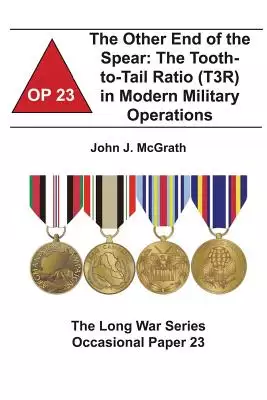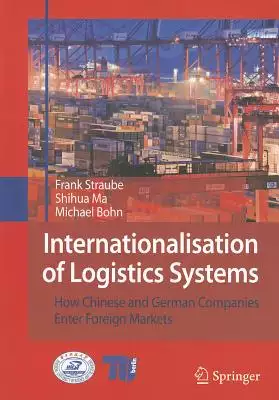What is logistics ma的問題,透過圖書和論文來找解法和答案更準確安心。 我們找到下列訂位、菜單、價格優惠和問答集
What is logistics ma的問題,我們搜遍了碩博士論文和台灣出版的書籍,推薦Mcgrath, John J./ Combat Studies Institute (COR)寫的 The Other End of the Spear: The Tooth-to-Tail Ratio (T3R) in Modern Military Operations 和Straube, Frank/ Ma, Shihua/ Bohn, Michael的 Internationalisation of Logistics Systems: How Chinese and German Companies Enter Foreign Markets都 可以從中找到所需的評價。
這兩本書分別來自 和所出版 。
逢甲大學 商學博士學位學程 賴文祥所指導 范志旻的 利用模糊層級分析法 探討半導體產業品牌影響因素之分析 (2021),提出What is logistics ma關鍵因素是什麼,來自於模糊層次分析法、半導體產業品牌、關鍵影響因素。
而第二篇論文朝陽科技大學 建築系建築及都市設計博士班 歐聖榮所指導 梅文兵的 社區適老化建設評估指標系統的建構與運用之研究 (2021),提出因為有 社區居家養老、社區、適老化建設、指標系統、評估的重點而找出了 What is logistics ma的解答。
除了What is logistics ma,大家也想知道這些:
The Other End of the Spear: The Tooth-to-Tail Ratio (T3R) in Modern Military Operations

為了解決What is logistics ma 的問題,作者Mcgrath, John J./ Combat Studies Institute (COR) 這樣論述:
John McGrath's The Other End of the Spear is a timely historical analysis and an important follow-on work to his earlier analysis of troop density trends in CSI Occasional Paper 16, Boots on the Ground. As that work showed, this paper also shows the timeless value of history and its relevance to cur
rent events. Boots on the Ground analyzed the ratio between the numbers of troops employed in military operations relative to the population in a number of irregular conflicts. This study analyzes the composition of such forces to answer the question: what have been the historical trends in the rati
o of deployed forces directly engaged in fighting, relative to those engaged in noncombat functions? This ratio is commonly, if inaccurately, called the "tooth-to-tail ratio." McGrath's study finds that the tooth-to-tail ratio, among types of deployed US forces, has steadily declined since World War
II, just as the nature of warfare itself has changed. At the same time, the percentage of deployed forces devoted to logistics functions and to base and life support functions have both increased, especially with the advent of the large-scale of use of civilian contractors. A segment of American mi
litary historians and policy makers has long been enamored with a genre of military history that seeks to quantify war, to reduce it to known variables, and to posit solutions to future military conflicts based on mathematical formulae. The practice of war contains a strong element of science, but i
n the end, the practice of war is an art. This study cannot be used to guarantee victory simply by composing a force of the proportional figures presented in the conclusion. However, it does provide a good baseline, based on historical precedent, for future planning. This work, coupled with Boots on
the Ground, provides a unique analysis of the size and composition of military forces as found in historical patterns. Policy makers, commanders, and staff officers should use these two studies as a basis from which to begin their analysis of the particular campaign at hand. They will then need to
apply their understanding of the objectives, the nature of the conflict, and local and regional culture and conditions to the analysis to create a winning military plan. It is our belief at CSI that this kind of historical analysis will inform and educate today's military and civilian leaders as the
y carry out our nation's most important policies. Boston native John McGrath has worked for the United States Army in one capacity or another since 1978. A retired Reserve officer, Mr. McGrath served in infantry, field artillery, and logistics units, both on active duty and as a reservist. Before
coming to work at the Combat Studies Institute, he worked for four years at the US Army Center of Military History in Washington, DC, as a historian and archivist. Prior to that, Mr. McGrath worked full time for the Unites States Army Reserve in Massachusetts for more than 15 years, both as an activ
e duty reservist and as a civilian military technician. He also served as a mobilized reservist in 1991 in Saudi Arabia with the 22d Support Command during Operation DEERT STORM as the command historian and in 1992 at the US Army Center of Military History as a research and writer. Mr. McGrath is a
graduate of Boston College, holds an MA in history from the University of Massachusetts at Boston, and is currently a PhD candidate at Kansas State University. He is the author of numerous articles and military history publications. He has published several books including "Theater Logistics in the
Gulf War" published by the Army Materiel Command in 1994, "The Brigade: A History" published by the US Army Combat Studies Institute (CSI) in 2005; and "Crossing the Line of Departure," also published by CSI in 2006. HE served as the general editor of the published proceedings from CSI’s 20054 Milit
ary History Symposium, "An Army at War: Change in the Midst of Conflict." Aside from a general interest in things military and historical, his areas of particular interest include modern military operations, the German army in World War II, August 1914, and the Union Army in the Civil War. He also h
as a keen interest in ancient history, historical linguistics, the city of Boston, and baseball. McGrath is also a current PhD candidate at Kansas State University.
利用模糊層級分析法 探討半導體產業品牌影響因素之分析
為了解決What is logistics ma 的問題,作者范志旻 這樣論述:
隨著時間的流逝,半導體創新正在發生變化,可以適用於不同的創新業務,半導體業務的發展至關重要,因而開闢了許多新的職位。半導體業務是一個融合了不同創新能力並協調上游,中途和下游提供商的專業能力的行業,並且通常具有較高的進入壁壘 。廠家已投入花費很多精力與成本進入這個行業,期盼永續經營與回饋利害關係人。本研究第一步採用PEST, 五力 & SWOT分析,在美國,日本和臺灣,這些是國際半導體供應商鏈中的關鍵成員。經過最新半導體有關文獻的討論和分析,發現現有廠商已經建立了行業品牌,並獲得了用戶的信任。因此,品牌研究在這個行業是大家一直在探索的領域。考慮到寫作對話和大師談話,本研究使用分析層次結構(A
HP)研究技術對品牌的關鍵指針在半導體品牌的關鍵部件上進行重要性的排序,然後利用模糊層次分析法(FAHP)來分析這些標記之間的聯繫。經調查,有11項顯著結果可供參考,關鍵是要在半導體品牌建設上取得優異的成績,“客戶價值”和“品牌資產”都必須達到一定的水平。本研究發現,半導體品牌策略應以“客戶價值”為核心,解決客戶問題,創造卓越價值,並隨著技術的進步不斷投入新產品的研發,以奠定半導體品牌長期成功的基礎。
Internationalisation of Logistics Systems: How Chinese and German Companies Enter Foreign Markets

為了解決What is logistics ma 的問題,作者Straube, Frank/ Ma, Shihua/ Bohn, Michael 這樣論述:
Over the past decades the world economy has reached an unprecedented level of global integration. As markets are being liberalised and trade barriers continuously being removed, companies are in an ongoing process of internationalisation. For the internationalisation of business activities, Global L
ogistics Systems play a significant role. The motivation of this survey is to review companies' internationalisation procedures from a logistics perspective. What are the challenges of setting up international logistics networks? What are the problems logistics managers must face when entering speci
fic markets? How do managers cope with these challenges to ensure that internationalisation projects will be successful? The research has been undertaken in China and Germany, surveying each country's companies when going global. Prof. Dr.-Ing. Frank Straube is the Director of the Logistics Depart
ment of the Institute of Technology and Management at the TUB since October 2004. He is Vice-President of the German logistics association ’Bundesvereinigung Logistik BVL e.V.’ and member of the Board of the European Logistics Association (ELA).Before his call to TUB, Frank Straube was Director and
Chairman of the Board of the Kuehne Institute for Logistics at the University of St. Gallen and Director of Studies of the Executive MBA course. He published extensively on the subject of logistics and is a renowned presenter on national and international conferences. Professor Ma Shihua is a profes
sor and the vice dean in School of Manangment, Huazhong Univeristy of Science and Technology (HUST), P.R. China. He is also the head of Institute of Supply Chain & Logistics Management, HUST. He has long been engaged in research and industrial practice in supply chain and logistics management, as we
ll as production and operations management. He is member of Instructive Committee of Higher Education of Management Science and Engineering, Ministry of Education of China. Also, He is senior Committee member of China Logistics Society. He offers several courses including supply chain management, op
erations management and logistics management for EMBA, MBA, graduate and undergraduate students. He has consulting experience with numerous companies in China. Prof. Ma has established long time cooperation with many firms, including Haier, etc.Dipl.-Ing. oec. Michael Bohn studied Industrial Enginee
ring and Management in Hamburg and Singapore. Since 2005 he his working as a Research Associate at the Competence Center for International Logistics Networks of the Berlin University of Technology (TU Berlin) where he his conducting research in the field of global logistics and is managing internati
onal research projects.
社區適老化建設評估指標系統的建構與運用之研究
為了解決What is logistics ma 的問題,作者梅文兵 這樣論述:
面對全球老齡化所帶來持續性養老壓力,各國政府都開展了行之有效的辦法來應對本國人口老齡化問題。隨著經濟的發展和房地產行業的興起,社區居家養老已經成為中國的主體養老模式,据數據統計,中國90%的老年人選擇社區居家養老。但不能否認的是,社區建設之初,較少考慮到老年人的養老需求,因此如何構建符合社區居家養老模式下社區適老化建設便成為政府、養老產業界和學術界共同關心的問題。基於此,本論文借鑒國內外相關建設和發展經驗,通過質性研究和量化分析相結合的研究方法,構建出社區居家養老模式下社區適老化建設評估指標體系,並選取中國珠三角地區4個典型社區進行實證運用,以期提出適合社區居家養老模式下社區適老化建設的對策
建議和改善策略。具體內容如下:首先,透過文獻資料調研、政策文本分析和老年扎根訪談的方式,運用質性研究方法,初步選取社區居家養老模式下社區適老化建設的51項評估指標;其次,將上述51項指標編制成模糊德爾菲法專家問卷,運用模糊德爾菲法,邀請官、產、學界專家對51項指標的重要值進行評量,根據專家共識值和門檻值的設定,最終篩選出48項社區適老化建設指標;再次,將上述48項指標的重要度和表現度,編制成問卷針對社區居家老年人及其相關群體進行廣泛調研,透過576份有效調研數據,運用因素分析法,構建出社區居家養老模式下社區適老化建設的4項準則、9項次準則和48項指標的評估指標系統;另外,將社區適老化建設評
估指標體系,編制成模糊層次專家問卷,邀請官、產、學界專家對各層級評估指標的相對重要值進行評量,運用模糊層次分析法,計算出社區適老化建設評估指標體系各層級指標的權重值;最後,透過本研究構建的社區適老化建設評估指標體系,選擇中國珠三角地區城市、城郊、城鎮、農村等4個典型社區進行實例驗證,客觀科學評估該社區適老化建設的狀況並根據評估數據提出改善策略。社區適老化建設評估指標的研究,是可以涵蓋多面向的研究,這不只是針對現有社區的適老化建設狀況進行評估,從其中辨識適老化建設的不足之處並提出改善建議,也可以於社區規劃建設前段作業時,協助相關部門有效的篩選建設指標並進行決策,以尋得符合社區居家養老產業需求之切
實適老化表現。本研究最期待的是藉由社區適老化建設評估指標,提升社區適老化建設成效和社區居家養老品質,進而提升老年人的生活品質和生活滿意度,幫助老年人成功老化。